Serving 106 students in grades 6-12, Peabody-burns Jr/sr High School ranks in the bottom 50% of all schools in Kansas for overall test scores (math proficiency is bottom 50%, and reading proficiency is bottom 50%).
The percentage of students achieving proficiency in math is 20-29% (which is approximately equal to the Kansas state average of 29%). The percentage of students achieving proficiency in reading/language arts is 11-19% (which is lower than the Kansas state average of 32%).
The student:teacher ratio of 10:1 is lower than the Kansas state level of 13:1.
Minority enrollment is 11% of the student body (majority Hispanic), which is lower than the Kansas state average of 39% (majority Hispanic).
Quick Stats (2025)
- Grades: 6-12
- Enrollment: 106 students
- Student:Teacher Ratio: 10:1
- Minority Enrollment: 11%
- Graduation Rate: ≥80% (Btm 50% in KS)
- Overall Testing Rank: Bottom 50%
- Math Proficiency: 20-29% (Btm 50%)
- Reading Proficiency: 11-19% (Btm 50%)
- Science Proficiency: 30-39% (Top 50%)
- Source: National Center for Education Statistics (NCES), KS Dept. of Education
Top Rankings
Peabody-burns Jr/sr High School ranks among the top 20% of public schools in Kansas for:
Category
Attribute
Community Size
Student Attention
School Overview
Peabody-burns Jr/sr High School's student population of 106 students has declined by 22% over five school years.
The teacher population of 11 teachers has declined by 26% over five school years.
Grades Offered
Grades 6-12
Total Students
106 students
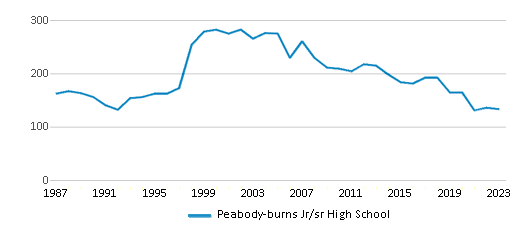
Gender %
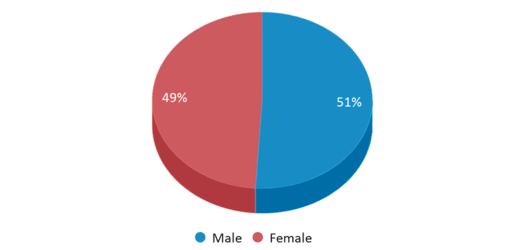
Total Classroom Teachers
11 teachers
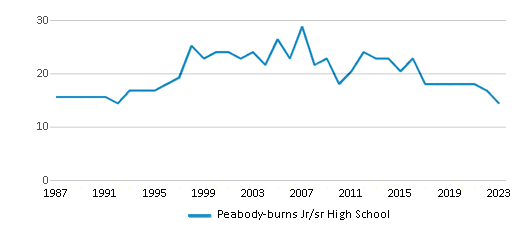
Students by Grade

School Rankings
Peabody-burns Jr/sr High School ranks within the bottom 50% of all 1,280 schools in Kansas (based off of combined math and reading proficiency testing data).
The diversity score of Peabody-burns Jr/sr High School is 0.21, which is less than the diversity score at state average of 0.57. The school's diversity has stayed relatively flat over five school years.
Overall Testing Rank
#982 out of 1280 schools
(Bottom 50%)
(Bottom 50%)
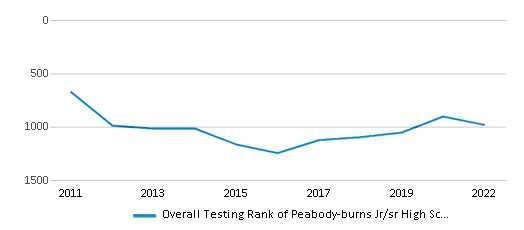
Math Test Scores (% Proficient)
20-29%
29%
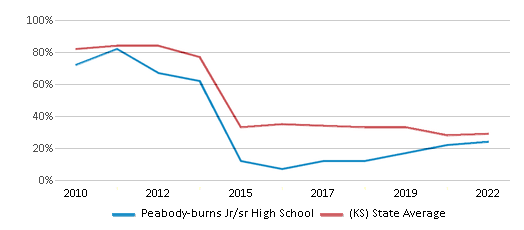
Reading/Language Arts Test Scores (% Proficient)
11-19%
32%
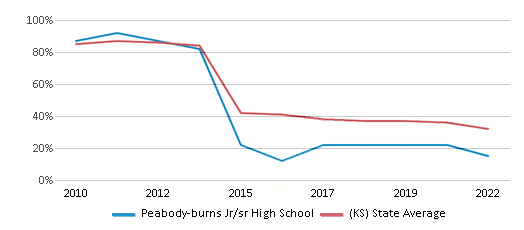
Science Test Scores (% Proficient)
30-39%
31%
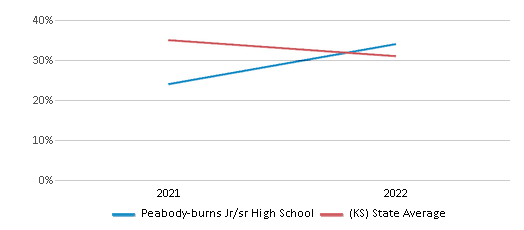
Student : Teacher Ratio
10:1
13:1
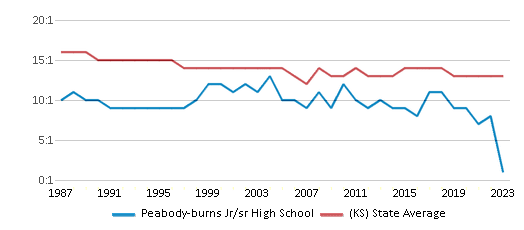
American Indian
1%
1%

Asian
n/a
3%
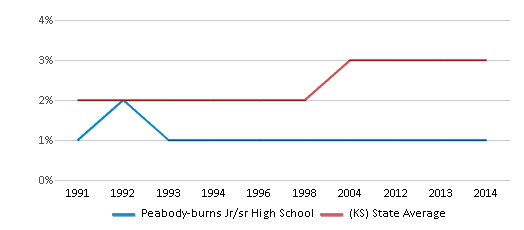
Hispanic
5%
22%
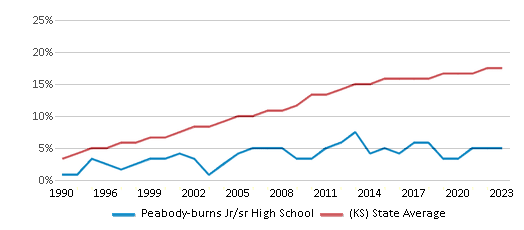
Black
1%
7%
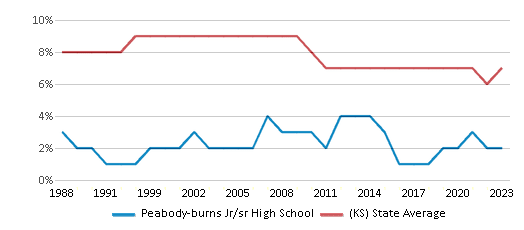
White
89%
61%
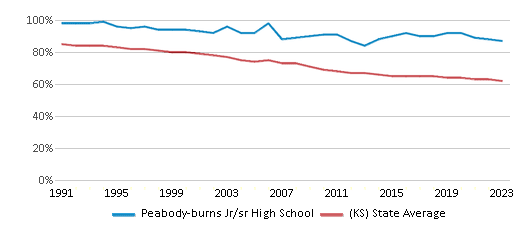
Hawaiian
n/a
n/a
Two or more races
4%
6%
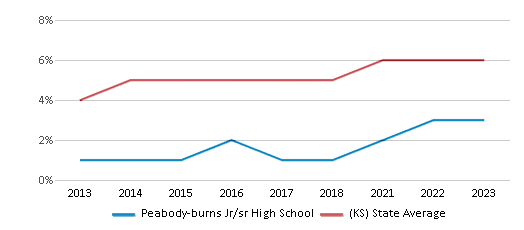
All Ethnic Groups
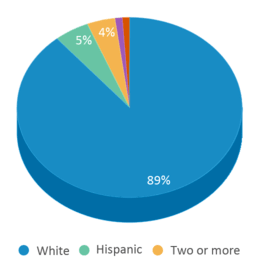
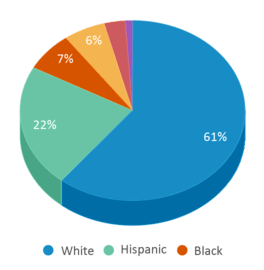
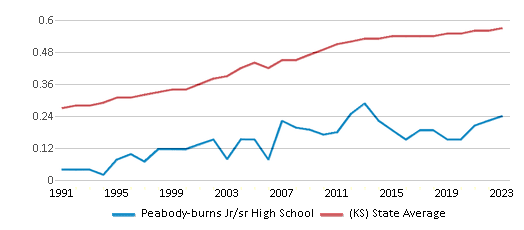
Graduation Rate
≥80%
89%
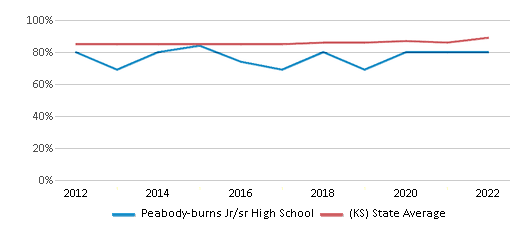
Participates in the National School Lunch Program (NSLP)
Yes
Eligible for Free Lunch
39%
42%
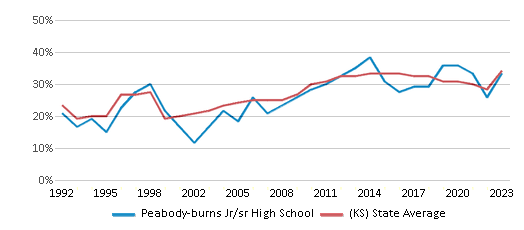
Eligible for Reduced Lunch
6%
7%
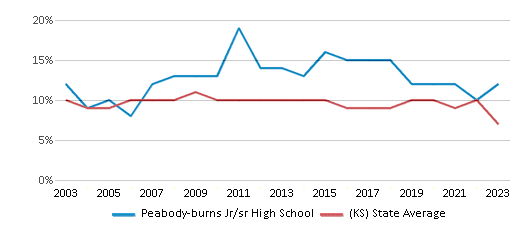
School Statewide Testing
School District Name
Source: National Center for Education Statistics (NCES), KS Dept. of Education
Profile last updated: 02/09/2025
Frequently Asked Questions
What is Peabody-burns Jr/sr High School's ranking?
Peabody-burns Jr/sr High School is ranked #982 out of 1,280 schools, which ranks it among the bottom 50% of public schools in Kansas.
What percent of students have achieved state testing proficiency in math and reading?
20-29% of students have achieved math proficiency (compared to the 29% KS state average), while 11-19% of students have achieved reading proficiency (compared to the 32% KS state average).
What is the graduation rate of Peabody-burns Jr/sr High School?
The graduation rate of Peabody-burns Jr/sr High School is 80%, which is lower than the Kansas state average of 89%.
How many students attend Peabody-burns Jr/sr High School?
106 students attend Peabody-burns Jr/sr High School.
What is the racial composition of the student body?
89% of Peabody-burns Jr/sr High School students are White, 5% of students are Hispanic, 4% of students are Two or more races, 1% of students are American Indian, and 1% of students are Black.
What is the student:teacher ratio of Peabody-burns Jr/sr High School?
Peabody-burns Jr/sr High School has a student ration of 10:1, which is lower than the Kansas state average of 13:1.
What grades does Peabody-burns Jr/sr High School offer ?
Peabody-burns Jr/sr High School offers enrollment in grades 6-12
What school district is Peabody-burns Jr/sr High School part of?
Peabody-burns Jr/sr High School is part of Peabody-Burns School District.
School Reviews
5 4/27/2010
Peabody-Burns is a phenomenal school. Excellent teachers and students. There have been tons of kids graduate from Peabody-Burns and lead succesful lives
2 4/15/2008
The school is so far behind in their teaching standards that kids leaving here and heading off to college are in for a big surprise. It will be way too hard for them. They are good with extracurricular activities, but not in studies. Not real great in letting parents be part of the festivities & School functions. They are good with athletic awards as well as academic, but they could be ranked higher if they would actually get some teachers to teach. Most of the teachers who have been there a while are good and should remain, but Some of the newer teachers neede direction. They are not experienced enough and my kids come home from school and show me their work, What a joke. Thank you.
Review Peabody-burns Jr/sr High School. Reviews should be a few sentences in length. Please include any comments on:
- Quality of academic programs, teachers, and facilities
- Availability of music, art, sports and other extracurricular activities
Recent Articles

What Is A Charter School?
Explore the world of charter schools in this comprehensive guide. Learn about their history, how they operate, and the pros and cons of this educational innovation. Discover key facts about charter schools, including admission policies, demographics, and funding, as well as what to look for when considering a charter school for your child.

10 Reasons Why High School Sports Benefit Students
Discover the 10 compelling reasons why high school sports are beneficial for students. This comprehensive article explores how athletics enhance academic performance, foster personal growth, and develop crucial life skills. From improved fitness and time management to leadership development and community representation, learn why participating in high school sports can be a game-changer for students' overall success and well-being.

February 05, 2025
Understanding the U.S. Department of Education: Structure, Impact, and EvolutionWe explore how the Department of Education shapes American education, from its cabinet-level leadership to its impact on millions of students, written for general audiences seeking clarity on this vital institution.





